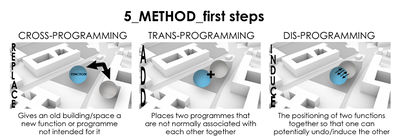atom10:REFERENCES
From student
(Difference between revisions)
(→References) |
|||
| (4 intermediate revisions by one user not shown) | |||
| Line 1: | Line 1: | ||
| + | <div style="width: 900px; "> | ||
| + | |||
__FORCETOC__ | __FORCETOC__ | ||
| Line 5: | Line 7: | ||
*'''LeFebvre: Rhythmanalysis''' | *'''LeFebvre: Rhythmanalysis''' | ||
| − | + | '''Definitions of rhythm''' | |
| − | + | '''RHYTHM''' = time + space + energy | |
| − | + | Everywhere where there is interaction between a place, a time and an expenditure of energy, there is rhythm. Therefore: | |
| + | a) repetition (of movements, gestures, action, situations, differences) | ||
| + | b) interferences of linear processes and cyclical processes | ||
| + | c) birth, growth, peak, then decline and end. | ||
| − | + | Rhythm is change and repetition, identity and difference, contrast and continuity. | |
| + | Lefebvre uses it as a mode of analysis – a tool. | ||
| − | + | The notion of rhythm brings with it also the notions of polyrhytmia, eurhythmia and arrhythmia. | |
| − | + | Lefebvre defines some categories to analyze rhythm: | |
| − | + | *Repetition and difference | |
| + | *Mechanical and organic | ||
| + | *Discovery and creation | ||
| + | *Cyclical and linear | ||
| + | *Contnuous and discontinuous | ||
| + | *Quantitative and qualitative. | ||
| − | + | [http://homepage.mac.com/bogronlund/get2net/Lefebvre_Rhythmanaslyses.html '''Rhytmanalysis'''] | |
| − | + | ---- | |
| − | |||
| − | |||
| − | |||
| − | + | *'''Bernard Tschumi: Architecture and disjunction''' | |
| − | + | '''Method''' | |
| + | ''Architecture is a combination of Space, Events and Movement without any hierarchy'' | ||
| + | (Bernard Tschumi) | ||
| − | + | [[File:5method.jpg|400px]] | |
| + | |||
| + | *The concepts of cross/trans/dis-programming will allow for a flow of dialogue by emphasizing transformation, adaptation and movement in design. | ||
| + | *Trans-programming can produce a path for urban interchange. The unexpected interaction resulting from this is the challenge. | ||
| + | *Dialogue between form and function results in spaces of urban interchange. In this way the flow of dialogue is not only increased between the different users of the space/building, but also between the users and the space/building/urban sourranding. | ||
| − | + | [http://books.google.com/books?id=72P3PQr2tqAC&printsec=frontcover&hl=it&source=gbs_ge_summary_r&cad=0#v=onepage&q=programming '''Architecture and disjunction'''] | |
| − | + | ---- | |
| − | |||
| − | |||
| − | |||
| − | + | *'''Manuel Lima: Visual complexity, Mapping Pattern of information''' | |
| − | + | [http://www.we-make-money-not-art.com/archives/2011/09/visual-complexity-mapping-patt.php '''Visual complexity'''] | |
| − | + | =='''Reasearch'''== | |
| − | [[atom10:Research]] | + | [[atom10:Research | Reasearch documents]] |
| Line 57: | Line 68: | ||
[[Atom10:Home| Back to Home]] | [[Atom10:Home| Back to Home]] | ||
| + | </div> | ||
Latest revision as of 10:14, 12 October 2011
Contents |
References
- LeFebvre: Rhythmanalysis
Definitions of rhythm
RHYTHM = time + space + energy
Everywhere where there is interaction between a place, a time and an expenditure of energy, there is rhythm. Therefore: a) repetition (of movements, gestures, action, situations, differences) b) interferences of linear processes and cyclical processes c) birth, growth, peak, then decline and end.
Rhythm is change and repetition, identity and difference, contrast and continuity. Lefebvre uses it as a mode of analysis – a tool.
The notion of rhythm brings with it also the notions of polyrhytmia, eurhythmia and arrhythmia.
Lefebvre defines some categories to analyze rhythm:
- Repetition and difference
- Mechanical and organic
- Discovery and creation
- Cyclical and linear
- Contnuous and discontinuous
- Quantitative and qualitative.
- Bernard Tschumi: Architecture and disjunction
Method Architecture is a combination of Space, Events and Movement without any hierarchy (Bernard Tschumi)
- The concepts of cross/trans/dis-programming will allow for a flow of dialogue by emphasizing transformation, adaptation and movement in design.
- Trans-programming can produce a path for urban interchange. The unexpected interaction resulting from this is the challenge.
- Dialogue between form and function results in spaces of urban interchange. In this way the flow of dialogue is not only increased between the different users of the space/building, but also between the users and the space/building/urban sourranding.
- Manuel Lima: Visual complexity, Mapping Pattern of information
Reasearch
Back to Home
